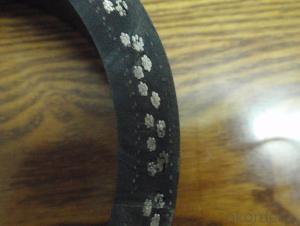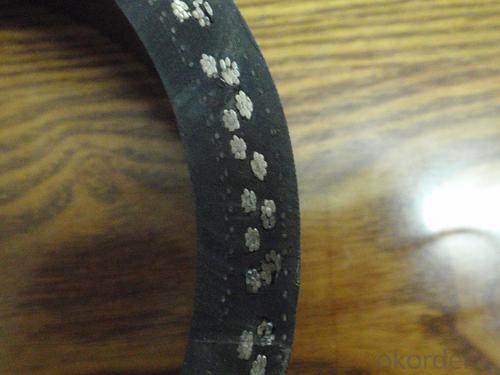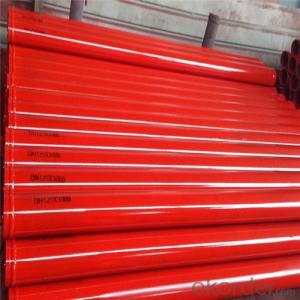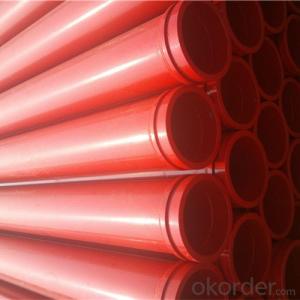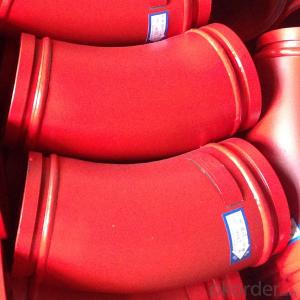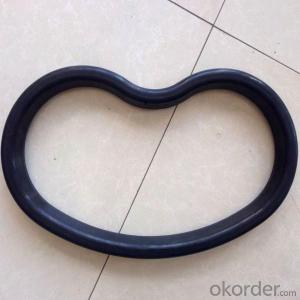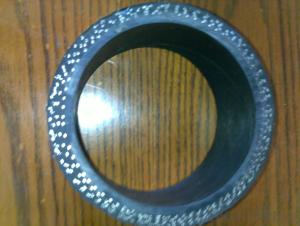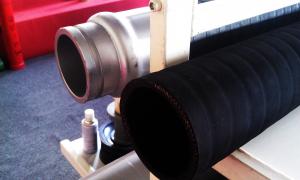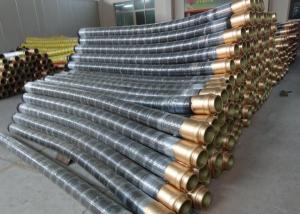Rubber End Hose of concrete pump parts --Reinforced with 2 steel layers
- Loading Port:
- China Main Port
- Payment Terms:
- TT OR LC
- Min Order Qty:
- -
- Supply Capability:
- -
OKorder Service Pledge
OKorder Financial Service
You Might Also Like
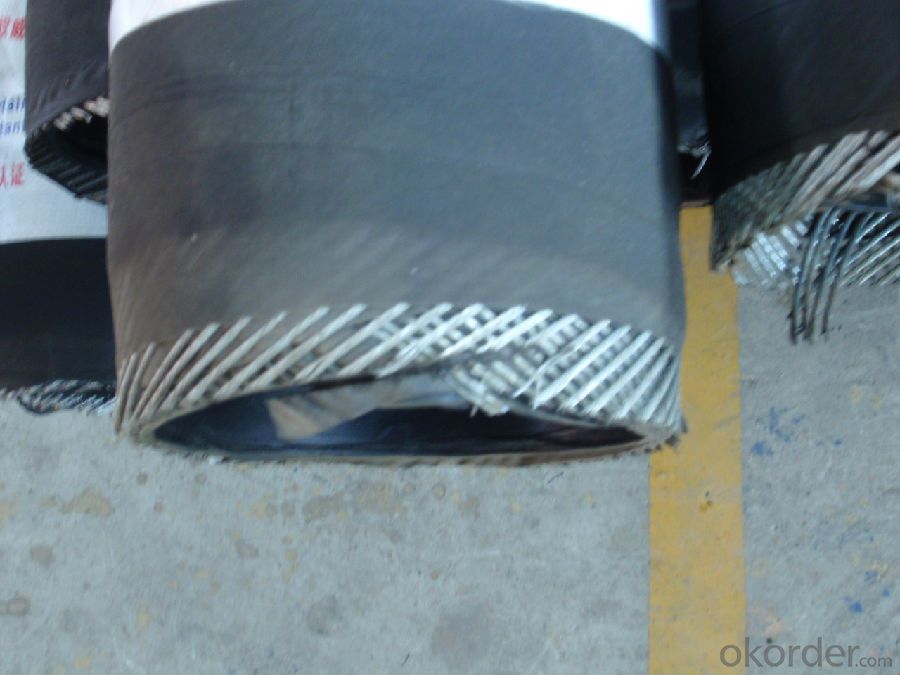
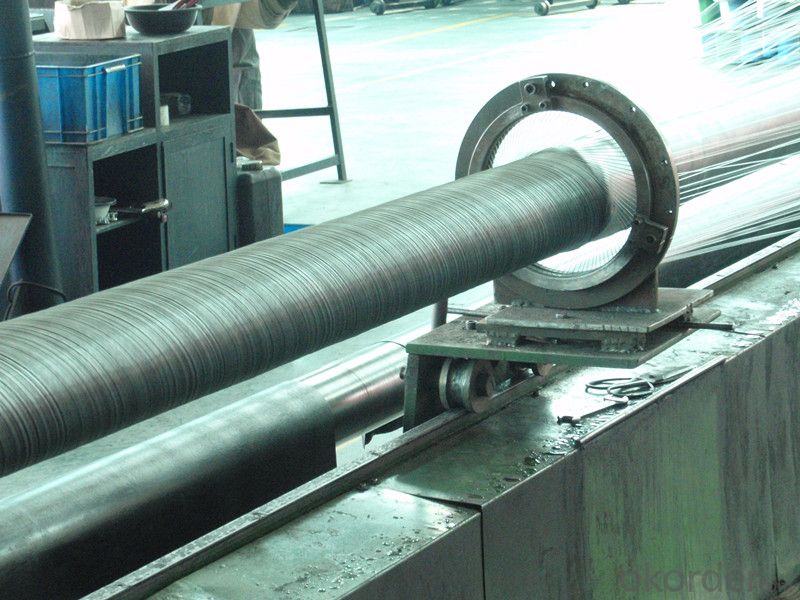
RUBBER END HOSE
1,2 layer wire steel
2,85 bar working-pressure
Length-------our normal 1-9 or according to client's requirment.
Packaging-----according to client‘s requirment.
Relevant Information:
Name | Concrete rubber hose; Delivery hose; End hose; Concrete pump hose; Boom hose |
Size | 2"/2.5"/3"/3.5"/4"/4.5"/5"/6"or according to client’s requirement |
Length | 3M,6M or Any length |
Reinforcement | Steel wire, tire cord or fabric |
Work Pressure | 85 to 1250(BAR/PSI) |
Burst Pressure | 200 to 2940(BAR/PSI) |
Service Life | 20,000 cubic meter |
Hose End | Galvanized, inner wall harden |
Application | Schwing, Putzmeister, Sany, Zoomlion, etc |
- Q: What are the consequences of using substandard concrete pump spare parts?
- Using substandard concrete pump spare parts can have several consequences. Firstly, substandard parts may not fit properly or be of the same quality as the original parts. This can lead to a decrease in the overall performance and efficiency of the concrete pump. The pump may not be able to deliver the required amount of concrete or may experience frequent breakdowns, resulting in project delays and increased costs. Secondly, substandard parts may have a shorter lifespan compared to genuine parts. This means that they may wear out or break down sooner, requiring more frequent replacements. This not only adds to the maintenance costs but also increases the risk of unexpected equipment failures during operation, which can be dangerous to the workers and potentially cause accidents. Furthermore, using substandard parts can compromise the safety of the concrete pump. Genuine parts are designed and manufactured to meet strict quality standards and ensure the proper functioning of the equipment. Substandard parts, on the other hand, may not undergo the same rigorous testing and quality control measures, making them less reliable and potentially more prone to failure. This can pose a serious risk to the operators and other personnel working in the vicinity of the concrete pump. Additionally, using substandard parts can also void any warranties or guarantees provided by the manufacturer. Manufacturers typically offer warranties on their products to ensure customer satisfaction and provide support in case of any issues. However, if substandard parts are used, the manufacturer may refuse to honor the warranty, leaving the owner responsible for any repairs or replacements needed. In summary, using substandard concrete pump spare parts can result in decreased performance, increased maintenance costs, higher risks of accidents, and the voiding of warranties. It is crucial to always use genuine parts that are specifically designed for the concrete pump to ensure its optimal performance, longevity, and safety.
- Q: How often should I replace concrete pump spare parts?
- The frequency of replacing spare parts for concrete pumps is determined by several factors, including the quality of the parts, how frequently they are used, and regular maintenance. It is generally recommended to regularly inspect and maintain the spare parts to detect any signs of wear or damage. As a precautionary measure, it is advisable to replace parts that display significant wear or are no longer functioning optimally. However, it is essential to adhere to the manufacturer's guidelines and recommendations for the specific model of concrete pump being used. Additionally, seeking advice from experienced professionals or technicians in the field can offer valuable insights into the expected lifespan of different spare parts and when replacements may be required.
- Q: What is the farthest pumping distance of concrete pump truck?
- Concrete pump, commonly known as to pump, or supporting pump, pumping height is determined by the power of the engine, 08 years in Guangzhou pearl, vanda heavy section pump made of C100 high strength concrete vertical height of 411 meters world record, the engine for the 572KW
- Q: Can concrete pump spare parts be repaired or refurbished?
- Concrete pump spare parts have the potential to be repaired or refurbished. Spare parts such as seals, bearings, valves, and hydraulic components can undergo repair or refurbishment processes, which can effectively prolong their lifespan and result in cost savings. The repair or refurbishment of these parts may involve the replacement of worn-out or damaged components, the reconditioning or re-machining of certain parts, and the execution of necessary maintenance and testing procedures to ensure their proper functionality. Moreover, some manufacturers or specialized companies may provide services specifically for repairing or refurbishing specific concrete pump spare parts, offering a more cost-effective alternative to purchasing entirely new parts. Nevertheless, it is crucial to acknowledge that not all spare parts are suitable for repair or refurbishment, especially if they are severely damaged or have exceeded their recommended service life. In such circumstances, it may be more practical and safer to opt for the replacement of these parts with new ones.
- Q: What are the causes of pipe blockage in concrete pump?
- Therefore, in the JGJ/T10-95 "concrete pumping construction technical regulations," stipulated that the sand through the 0.315mm sieve shall not be less than 15%.
- Q: How can one determine the correct size and dimensions of concrete pump spare parts?
- To determine the correct size and dimensions of concrete pump spare parts, there are several important steps to follow: 1. Identify the specific make and model of your concrete pump: Each concrete pump has its own unique specifications and requirements for spare parts. Therefore, it is crucial to know the make and model of your pump before ordering any spare parts. 2. Consult the manufacturer's documentation: Manufacturers often provide detailed documentation that includes information on the required size and dimensions of spare parts. This documentation may include technical drawings, diagrams, and part numbers that can help you find the correct size. 3. Measure the existing spare part: If you already have a spare part that needs replacement, you can measure its size and dimensions using precision tools like calipers or a measuring tape. Take accurate measurements of key dimensions such as length, width, height, and any other relevant specifications. 4. Seek professional assistance: If you are unsure about the correct size and dimensions, it is advisable to consult with a professional or an authorized dealer. They have expertise in concrete pumps and can guide you in selecting the right spare parts based on your pump's specifications. 5. Consider compatibility and quality: When purchasing spare parts, ensure they are compatible with your concrete pump's make and model. Additionally, prioritize quality to ensure longevity and optimal performance. Buying from reputable suppliers or directly from the manufacturer can help ensure the spare parts meet the necessary size, dimensions, and quality standards. By following these steps, you can accurately determine the correct size and dimensions of concrete pump spare parts, ensuring smooth operation and minimizing downtime.
- Q: Are there any warranties or guarantees available for concrete pump spare parts?
- Yes, there are warranties and guarantees available for concrete pump spare parts. Many manufacturers and suppliers offer warranties to ensure the quality and performance of their products. These warranties typically cover defects in materials or workmanship and provide a certain period of coverage, usually ranging from a few months to a year or more. Additionally, some suppliers may offer guarantees on the performance or durability of their spare parts, providing assurance and peace of mind to the customers. It is always recommended to inquire about the specific warranty or guarantee terms before purchasing concrete pump spare parts to ensure that you are protected in case of any issues.
- Q: What are the potential risks associated with the installation and replacement of concrete pump spare parts?
- The installation and replacement of concrete pump spare parts come with various potential risks. Improper installation is a key risk, as it can cause leaks, reduced performance, and even equipment failure. This not only leads to expensive repairs but also poses a safety threat to workers and those nearby. Another risk is the use of counterfeit or low-quality spare parts. These parts may not meet the necessary standards, compromising the integrity and functionality of the concrete pump. This increases the likelihood of equipment failure and accidents. Moreover, the installation and replacement process may involve operating heavy machinery like cranes or forklifts, which can be dangerous if not done correctly. Inadequate precautions can result in accidents, injuries, or damage to the equipment or surrounding structures. Additionally, concrete pump spare parts may contain hazardous materials or substances. Workers must be aware of the risks associated with handling and disposing of these materials, such as exposure to harmful chemicals or environmental contamination. Lastly, there is a risk of delays and downtime during the installation and replacement process. If spare parts are not readily available or compatibility issues arise, equipment may be inoperable for extended periods. This can cause project delays, increased costs, and potential financial losses. To mitigate these risks, it is crucial to provide proper training and supervision to workers involved in the installation and replacement of concrete pump spare parts. Using genuine and high-quality spare parts from reputable suppliers can also reduce the risk of equipment failure. Regular inspections, maintenance, and adherence to safety protocols are essential to minimize potential risks associated with this process.
- Q: What are the advantages of using genuine spare parts for my concrete pump?
- Using genuine spare parts for your concrete pump comes with several advantages. First and foremost, genuine spare parts are specifically designed and manufactured by the original equipment manufacturer (OEM) for your concrete pump. This means that they are made to fit perfectly and function optimally with your specific model. Using genuine parts ensures compatibility and reduces the risk of compatibility issues or malfunctions that can arise from using aftermarket or counterfeit parts. Secondly, genuine spare parts are made from high-quality materials and undergo rigorous testing to meet strict quality standards. This ensures their durability, reliability, and performance, ultimately resulting in longer service life and reduced downtime for your concrete pump. Genuine parts are designed to withstand the demanding conditions and heavy loads that concrete pumps typically operate under. Moreover, using genuine spare parts helps maintain the warranty and integrity of your concrete pump. Many manufacturers offer warranties that cover the use of genuine parts. By using genuine parts, you can take advantage of the warranty benefits and avoid any potential issues that may arise from using non-genuine parts, which could void the warranty. Additionally, genuine spare parts often come with technical support and expertise from the manufacturer. OEMs have extensive knowledge and experience with their equipment, and their technical support team can provide guidance, advice, and troubleshooting assistance in case any issues arise. This can be extremely beneficial in minimizing downtime and maximizing the efficiency of your concrete pump. Lastly, using genuine spare parts ensures the safety of your equipment and operators. Genuine parts are manufactured to meet strict safety regulations and standards, reducing the risk of accidents or failures that can result from using substandard or counterfeit parts. The safety and well-being of your team should always be a top priority, and using genuine parts helps ensure their protection. In conclusion, the advantages of using genuine spare parts for your concrete pump include compatibility, quality, durability, warranty coverage, technical support, and safety. Investing in genuine parts not only enhances the performance and longevity of your equipment but also provides peace of mind for both you and your team.
- Q: Can concrete pump spare parts be ordered in bulk quantities for future use?
- Yes, concrete pump spare parts can definitely be ordered in bulk quantities for future use. Many suppliers and manufacturers offer bulk ordering options to cater to the needs of contractors and construction companies. Ordering in bulk can provide several advantages such as cost savings, convenience, and ensuring a consistent supply of spare parts for maintenance and repairs. It is always recommended to have spare parts readily available to minimize downtime and maximize the efficiency and performance of concrete pumps.
Send your message to us
Rubber End Hose of concrete pump parts --Reinforced with 2 steel layers
- Loading Port:
- China Main Port
- Payment Terms:
- TT OR LC
- Min Order Qty:
- -
- Supply Capability:
- -
OKorder Service Pledge
OKorder Financial Service
Similar products
Hot products
Hot Searches
Related keywords
